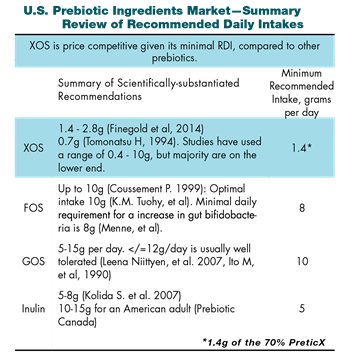Promotional Features
Research shows XOS is preferred prebiotic due to small dosage requirement; ideal for functional food and beverage applications
Following decades of extensive research, clinicians and scientists understand that as much as 70% of our immune function is located in the gut, where a complex microbial ecosystem which is delicately balanced between friendly and unfriendly microorganisms exists. The gut, by some estimates contains over 100 trillion microorganisms with bacteria from more than 1,000 different species, mostly Firmicutes and Bacteroidetes. There is increasing interest in changing the microflora environment by the use of prebiotics, and as an important “fertilizer” for probiotics, in order to achieve a healthy balance and potentially increasing the Bifidobacteria and optimizing the Firmicute/Bacteroidete ratio. This is of particular importance in an aging population where the number of healthy bacteria tends to decline.
What is a prebiotic?
Prebiotic as a definition can be traced back to 1995 and can be loosely defined as a non-digestible food ingredient that helps to support the growth of the probiotic bacteria. The 2007 Food and Agriculture Organization of the United Nations (FAO) Technical Meeting Report on Prebiotics classified among others Xylo-oligosaccharides (XOS) as prebiotics. Other prebiotics include Inulin Fructo-oligosaccharides (FOS) and Galacto-oligosaccharides (GOS).
Why XOS?
XOS is seen to be a highly desirable prebiotic due to the small effective dosage required, which minimizes gastrointestinal side effects and allows it to be easily incorporated into both functional foods and dietary supplements at a competitive cost per dose for the formulator.
Prebiotic awareness growing as part of overall trend in digestive health boom
As many as 70 million people are affected by impaired digestion ranging from chronic constipation to inflammatory bowel disease. Consumers seem to be aware of the need to take care of their digestive systems and understand the concept of probiotics. The future growth of prebiotics will be in part due to the trend to support probiotics with prebiotics either separately or together. AIDP is supporting a survey on consumer prebiotic and probiotic awareness in addition to continuing to support the research into the health benefits and claims associated with taking the recommended daily intake (RDI) of prebiotic ingredients.
Study confirms XOS beneficial for good gut bacteria
AIDP’s XOS prebiotic PreticX was recently the subject of a double-blind, randomized, placebo-controlled study conducted by researchers at the University of California Los Angeles (UCLA), published in the Frontiers of Physiology[1]. The study found daily doses as low as 1gram of significantly modified gut microbiota were associated with the growth of more species of good gut bacteria and a reduction in bad bacteria in both healthy people, and those who are overweight with unhealthy blood glucose levels.
XOS can become the prebiotic of choice for functional foods due to its unique benefits:
- XOS (PreticX) is non-GMO project-verified and has been clinically shown to increase bifidobacteria in the colon and aid in healthy digestion, as well as being effective at low inclusion rates, making it a versatile and stable ingredient for use in both supplements and food products.
- XOS was shown to decrease the Firmicutes/Bacteroidetes ratio in recent UCLA studies [1][2]. An increased Firmicutes/Bacteroidetes ratio has been suggested to be associated with unhealthy gut microbiota in overweight people.[2,[3]
- XOS is a competitively priced prebiotic ingredient which can be used at low doses and presents a compelling option in both foods and supplements to effectively target and promote growth of specific gut bacteria that are already present in the large intestine. The ingredient is safe, efficacious, and stable. It presents few side effects and has been successfully used in Japan for years.
- XOS has a considerable number of structure function claims with an FDA no objection notice.
- XOS (PreticX) is Generally Recognized as Safe (GRAS) notified for use in food (GRN458).
- XOS is suitable for use in a wide range of foods and formulations, including protein ready-to-drink (RTD) meal replacements, yogurts, tablets, bars, gummies, chewing gum and applications, where probiotics are not applicable, due to its excellent stability over a wide range of pH values (2.3-8) and temperatures (up to 120 °C).
- XOS has a slightly sweet profile, being 40% as sweet as sucrose, but is low in calories. This makes it a natural fit for low-calorie products.
- XOS benefits intestinal flora without the need for refrigeration and without potency loss.
- XOS can be used with protein powders, overcoming some of the constipation and other digestion problems associated with high protein diets.
Timing ideal for next era of digestive health ingredients
While probiotics have enjoyed the spotlight recently, prebiotics are clearly the up-and-comers as the “new era” for digestive health. XOS outweighs other prebiotics in its benefits to consumers and for formulators searching to add digestive health benefits to their finished products.
# # #
AIDP is a leader in functional ingredients, with a focus on extensively researched products that meet consumer demand for wellness and healthy aging. Our commitment is to source high-quality ingredients and provides proprietary solutions that address formulation challenges. AIDP's success is grounded in its depth of experience and commitment to strong science for functional food and beverage product development.
These statements have not been evaluated by the Food and Drug Administration. This product is not intended to diagnose, treat, cure, or prevent any disease.
[1]Yang J, Summanen PH, Henning SM, Hsu M, Lam H, Huang J, Tseng CH, Dowd SE, Finegold SM, Heber D, et al. Front Physiol. 2015; 6:216. Epub 2015 Aug 7.
[2]S.M. Finegold, Z. Li, P.H. Summanen, J. Downes, G. Thames, K. Corbett, S. Dowd, M. Krak, D. Heber. Food Funct. 2014 Mar;5(3):436-45.
[3]R. E. Ley, P. J. Turnbaugh, S. Klein and J. I. Gordon. Nature, 2006, 444, 1022–1023.




